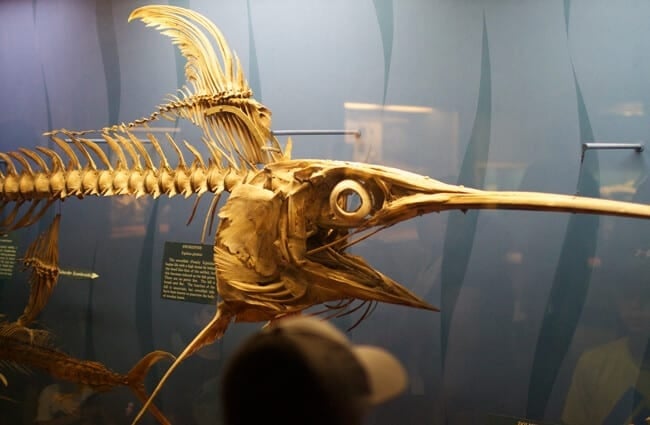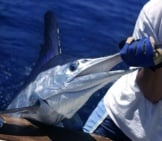Swordfish, also known as “broadbills,” are large migratory fish. They are speedy, powerful predators and highly prized in the sport fishing community. These fish are named for their long, sword-like flattened bill. Though they superficially look similar to other large billfish, they are actually in their own taxonomic family and not closely related to other billfish like marlin or sailfish. Read on to learn about the swordfish.
Description of the Swordfish
These creatures have very hydrodynamic body shapes. They are usually around 10 ft. long, though individuals nearly 15 ft. long have been reported. Their characteristic “sword” is pointed at the end and flattened. The sword can grow to be as much as 2 ft. long! This fish’s dorsal fin is tall and narrow, and slightly curved backwards.
Interesting Facts About the Swordfish
These skilled predators use agility and power to capture prey. Though they are a tasty meal, there is more to swordfishes than their value for food and sport. Learn more about these unique creatures below.
- Slice and Dice – In contrast to what you may expect, they do not stab their prey with their sword. Instead, they slash back and forth to stun and injure fish before eating them. This is most commonly used for larger prey, and smaller prey is simply snatched up using impressive speed.
- Speedster – The most important hunting tool this predator possesses is not their long bill, but their impressive speed. This impressive fish has been recorded swimming at speeds up to 60 mph while hunting. This is just slightly slower than the fastest fish in the ocean, the sailfish.
- Breach! – While swimming at high speeds these fish have been known to leap above the surface of the water in a behavior called “breaching.” Scientists believe that breaching could be a method of reducing parasites.
- Precarious Prey – A fully-grown swordfish makes for one intimidating foe. With their dangerous bill, impressive speed, and large build, it takes a skilled predator to kill one of these fish. Their only natural predators are killer whales and the speedy shortfin mako shark. The danger of hunting these fish is evident, as dead mako sharks with swordfish bills embedded in their skulls have been found on multiple occasions.
Habitat of the Swordfish
These fish can be found in water temperatures anywhere from 41º to 81º F, but they are most common between 64º and 72º F. This makes them most common in tropical and temperate oceans. In the water column they can be found anywhere from the surface to 9,422 ft. deep, but are more commonly found around 1,800 ft. deep.
Distribution of the Swordfish
These widespread and migratory fish can be found nearly worldwide. They are found in temperate and tropical oceans across the planet. They are not found in the seas nearest the poles, and are restricted to temperatures between 41º and 81º F.
Diet of the Swordfish
These fish are piscivores, which means they prey on other fish species. Some common prey species includes mackerel, barracuda, squid, herring, hake, lanternfish, rockfish, bluefish, cod, tuna, bonito, and butterfish. They use their sword to slash at (not stab) prey, which stuns or injures them. Their impressive speed allows them to outswim their prey species.
Swordfish and Human Interaction
Humans have fished for these powerful fish for hundreds of years. They were traditionally harpooned, which resulted in a long, strenuous battle. Their populations were heavily impacted by the introduction of long-line fishing, a fishing method where long lines with multiple hooks are left for long periods.
This led to strong regulation of commercial fisheries, allowing swordfish populations to increase to sustainable rates. To avoid eating seafood that is unsustainable and at risk of extinction please see Monterey Bay Aquarium’s .
Domestication
These fish have not been domesticated in any way.
Does the Swordfish Make a Good Pet
They do not make good pets as they are much too large to keep in a home aquarium. Their speed also poses a danger to themselves if they collide with the sides of an aquarium.
Swordfish Care
We know little about what it would take to care for these fish in aquariums. They are immensely fast, which means that if they are startled and swim into the side of a tank they can be mortally injured. Though we can attempt to replicate their natural prey, it is unlikely that they would be able to survive in aquariums.
Behavior of the Swordfish
These predators are solitary fish, but will occasionally aggregate in loose schools. When they are found in groups, they are usually separated by an average of 33 ft. between individuals. While they are occasionally found basking at the surface of the ocean, during the day they are normally found much deeper. In the daytime they are found around 1,800 ft. deep, and at night they swim to the surface to feed.
Reproduction of the Swordfish
Swordfish migrate to warmer waters to spawn. The larger the female, the more eggs she will produce, and some females have been recorded to release as many as 29 million eggs! They are oviparous, which means that they have internal fertilization and lay eggs. Only a small percent of eggs will mature into adults.









![Red Angus Closeup of a beautiful Red Angus cowPhoto by: U.S. Department of Agriculture [pubic domain]https://creativecommons.org/licenses/by/2.0/](https://animals.net/wp-content/uploads/2020/03/Red-Angus-4-238x178.jpg)












![Red Angus Closeup of a beautiful Red Angus cowPhoto by: U.S. Department of Agriculture [pubic domain]https://creativecommons.org/licenses/by/2.0/](https://animals.net/wp-content/uploads/2020/03/Red-Angus-4-100x75.jpg)

